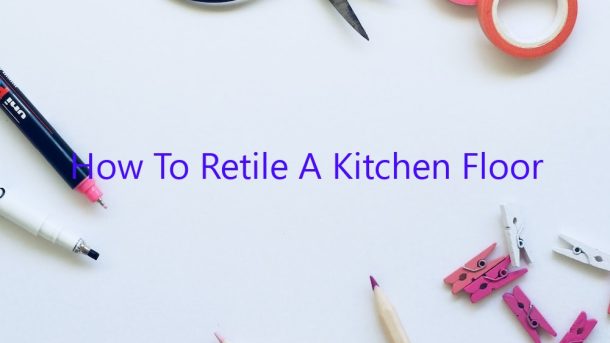Retiling a kitchen floor can be a daunting task, but with the right tools and instructions it can be a breeze. Here is a simple guide on how to retile a kitchen floor:
1. Clear the Floor: The first step is to clear the floor of any furniture or appliances.
2. Remove the Old Tiles: Use a chisel and hammer to remove the old tiles. Be careful not to damage the underlying substrate.
3. Measure and Cut the New Tiles: Measure the dimensions of the floor and cut the new tiles using a tile cutter.
4. Apply Adhesive: Apply adhesive to the back of the tiles and press them into place.
5. Grout the Tiles: Once the adhesive has set, use a grout float to apply grout between the tiles.
6. Clean the Tiles: Wipe down the tiles with a damp cloth to remove any grout residue.
7. Seal the Tiles: Apply a sealant to the tiles to protect them from staining and damage.
Contents
How much does it cost to retile a kitchen floor?
When it comes to home improvement projects, retiling a kitchen floor is a job that often falls near the top of the list in terms of expense. Depending on the size of your kitchen, the type of tile you choose, and the amount of labor involved, you can expect to pay anywhere from a few hundred dollars to well over a thousand dollars for a professional to retile your kitchen floor.
The first factor that will affect the cost of retiling your kitchen floor is the size of the kitchen. Larger kitchens will naturally require more tiles, which means you’ll end up spending more money. Additionally, the complexity of the layout may also add to the cost, as certain patterns or designs can be more time-consuming and labor-intensive to install than others.
The type of tile you choose is another important factor that will affect the overall cost of the project. Some tiles are more expensive than others, and certain materials may also require more or less maintenance in the future. Porcelain and ceramic tiles are two of the most popular choices, and they both come in a variety of colors and styles. However, they are also generally more expensive than other materials like vinyl or linoleum.
The final factor that will impact the cost of retiling your kitchen floor is the amount of labor involved. If you choose to do the job yourself, you can save a significant amount of money, but it will require a good deal of time and effort. If you hire a professional, the cost will be higher, but you won’t have to worry about the hassle and mess involved in the installation process.
Can you retile a kitchen floor?
Can you retile a kitchen floor?
Yes, you can retile a kitchen floor. However, there are a few things that you need to keep in mind before you start.
The first thing you need to do is determine whether or not your floor is suitable for retiling. Most kitchen floors are made from either ceramic or vinyl tiles, both of which can be successfully retiled. However, if your floor is made from a different material, such as wood, you may not be able to retile it.
You’ll also need to make sure that your floor is in good condition. If there are any cracks or holes in the surface, they will need to be fixed before you can start retiling.
Once you’ve determined that your floor is suitable and in good condition, you can start planning your renovation. First, you’ll need to remove the old tiles. This can be a bit of a challenge, especially if the tiles are glued down. However, with a bit of effort, you should be able to get them removed.
Once the old tiles are gone, you can start installing the new tiles. Be sure to follow the manufacturer’s instructions carefully, and make sure that you use the correct type of adhesive.
It’s usually a good idea to hire a professional to do the retiling job for you. This will ensure that the job is done properly, and that you don’t run the risk of damaging your floor.
If you’re thinking about retiling your kitchen floor, be sure to keep these things in mind. It’s a challenging job, but it’s definitely worth it in the end.
How can I update my kitchen floor tiles without removing them?
Updating your kitchen floor tiles can be a great way to give your kitchen a new look without spending a lot of money. However, if your kitchen floor tiles are old and outdated, you may be wondering if you can update them without removing them. The good news is that you can, but there are a few things you need to keep in mind.
One of the easiest ways to update your kitchen floor tiles without removing them is to change the color of the tiles. This can be done by painting the tiles with a tile paint or by using a tile adhesive to attach new tiles to the old tiles. If you want to change the shape of the tiles, you can also use a tile adhesive to attach new tiles to the old tiles.
Another way to update your kitchen floor tiles without removing them is to install a new flooring material over the old tiles. This can be done by installing a plywood subfloor over the old tiles and then installing the new flooring material on top of the plywood. If you choose to install a new flooring material over the old tiles, make sure that the new flooring is compatible with the old flooring. For example, if you are installing a vinyl floor over the old tiles, make sure that the vinyl floor is compatible with the adhesive used to install the tiles.
If you don’t want to remove the old tiles, you can also try to hide them by installing a new flooring material over them. This can be done by installing a new flooring material on top of the old tiles or by installing a new flooring material in front of the old tiles. If you choose to install a new flooring material over the old tiles, make sure that the new flooring is compatible with the old flooring. For example, if you are installing a vinyl floor over the old tiles, make sure that the vinyl floor is compatible with the adhesive used to install the tiles.
If you are not happy with the look of your kitchen floor tiles, there are a few things you can do to update them without removing them. If you want to change the color of the tiles, you can paint them with a tile paint or use a tile adhesive to attach new tiles to the old tiles. If you want to change the shape of the tiles, you can also use a tile adhesive to attach new tiles to the old tiles. Another way to update your kitchen floor tiles without removing them is to install a new flooring material over the old tiles. If you don’t want to remove the old tiles, you can also try to hide them by installing a new flooring material over them.
How do you redo a kitchen floor without removing cabinets?
There are a few ways that you can redo a kitchen floor without having to remove the cabinets. One way is to install a new floor directly over the old one. This can be done with vinyl, laminate, or engineered hardwood flooring. If you decide to go this route, you will need to make sure that the flooring is compatible with the type of subfloor that you have. Another option is to remove the cabinets and then install the new flooring. This option is a little more labor-intensive, but it will give you a chance to update your cabinets at the same time. Finally, you can also install a new floor in a different color or style than your current floor. This can be a great way to change the look of your kitchen without having to do a lot of work.
Is tiling over tiles a good idea?
Tile flooring is a popular option because it is durable and easy to clean. However, some homeowners may wonder if tiling over an existing tile floor is a good idea. In some cases, it can be, but there are also a few things to consider before making a decision.
If the existing tile floor is in good condition and does not have any major defects, tiling over it can be a good option. This is because the new tile will adhere to the existing tile and create a solid surface. Additionally, tiling over tile can be a more affordable option than removing the old tile and installing new tile flooring.
However, there are a few things to keep in mind before tiling over tile. First, the new tile may not match the existing tile exactly, so it is important to choose a color and style that will be cohesive. Second, the existing tile may not be level, so the new tile may not lay flat. This can be corrected by using a leveling compound before tiling.
Overall, tiling over tile is a viable option in some cases. However, it is important to consider the condition of the existing tile and the overall look that is desired before making a final decision.
Do you install kitchen cabinets before tile flooring?
Tile flooring is a popular choice for kitchens because of its durability and easy cleaning. Kitchen cabinets are also a popular choice for kitchens, and there are a few different ways to install them. Some people choose to install the cabinets first and then install the tile flooring around them, while others choose to install the tile flooring first and then install the cabinets. So, which is the best way to install kitchen cabinets?
Installing kitchen cabinets before tile flooring is the most common way to do it. This is because it is often easier to install the cabinets first and then install the tile flooring around them. When you install the cabinets first, you have a solid surface to install the tile flooring on, and you can install the tile flooring right up to the edge of the cabinets. This can help to create a cohesive look in your kitchen.
However, there are a few drawbacks to installing the cabinets first. First of all, it can be difficult to install the cabinets accurately if you are not a professional. If the cabinets are not installed correctly, they may not be level or they may not fit properly in the space. Additionally, if there are any problems with the cabinets, such as water damage, it can be difficult to fix them if the tile flooring is already installed.
Installing the tile flooring first is also a popular option. When you install the tile flooring first, you have a solid surface to install the cabinets on. This can make it easier to install the cabinets accurately, and it can also help to prevent any problems with the cabinets, such as water damage. Additionally, if there are any problems with the tile flooring, it is easier to fix them if the cabinets are not already installed.
However, there are a few drawbacks to installing the tile flooring first. First of all, it can be difficult to install the tile flooring accurately if you are not a professional. Additionally, it can be difficult to install the cabinets around the tile flooring if the tile flooring is already installed. This can create a lot of extra work and it can also be difficult to get a cohesive look in your kitchen.
So, which is the best way to install kitchen cabinets? The answer depends on your own preferences and on the layout of your kitchen. If you are comfortable installing kitchen cabinets and you are confident that you can do it correctly, then installing the cabinets first may be the best option for you. If you are not comfortable installing kitchen cabinets, or if you are not confident in your ability to do it correctly, then installing the tile flooring first may be a better option for you.
Where do you start when tiling a kitchen floor?
When it comes to tiling a kitchen floor, you may be wondering where to start. Here is a guide to help you get started.
Pick the Right Tile
The first step is to choose the right tile. You’ll want to consider the size and shape of the tiles, as well as the color and style. You’ll also need to decide on the type of tile you want to use. There are several options, including ceramic, porcelain, and stone tiles.
Measure the Floor
Once you’ve chosen the tile, you’ll need to measure the floor to make sure you have enough tile. You’ll also need to measure the height of the doorways and other obstacles so you can account for them when you’re planning the layout.
Plan the Layout
Next, you’ll need to plan the layout. You’ll need to decide where to place the tiles and how to connect them. You’ll also need to decide on the pattern you want to use.
Prepare the Floor
Before you can tile the floor, you’ll need to prepare the surface. This may involve removing the old flooring, patching any holes or cracks, and leveling the surface.
adhesive
tile cutter
trowel
bucket
sponge
level
measuring tape
pencil
marker
notepad
chalk line




